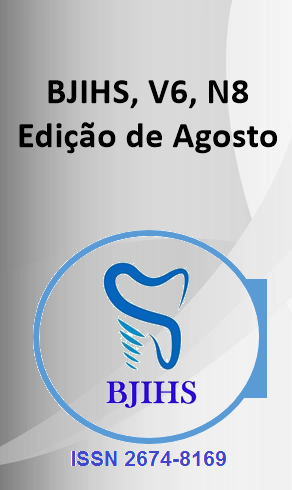Abstract
Introduction: The endotracheal aspiration technique is a procedure that aims to remove accumulated pulmonary secretions. It is intended for patients in the Intensive Care Unit (ICU), tracheostomized or intubated. Due to needs over time, strategies were developed such as instillation of saline solution (0.9%) or distilled water associated with implementation in practice. Objectives: Review the literature regarding the use of distilled water or saline solution (0.9%) in endotracheal aspiration.Methodology: This is a bibliographical review, where searches were carried out in the following databases: SciELO, Google Scholar and LILACS. The inclusion criteria were: most recent articles published in the period from 2020 to 2022. A total of 7 studies were found, which corresponded to the previously established inclusion criteria. The following descriptors were used: Endotracheal aspiration, 0.9% saline, Distilled water. Results and discussions: The study analyzed seven articles on the use of saline and distilled water for endotracheal suctioning, finding agreement on the preference for saline due to its effectiveness in removing secretions and better acceptance by patients. However, concerns have been raised about the potential displacement of pathogenic bacteria and possible adverse effects. However, although some articles mentioned benefits of distilled water, such as availability and cost, they warned of risks such as electrolyte imbalance and bacterial contamination. Therefore, the result of this research concludes that saline solution is the best choice. Conclusion: Despite this, the research concluded that saline is the best option for endotracheal aspiration, as it shows versatility that is often used in health treatments, due to its safety and compatibility with biological tissues due to its composition. simple.
References
SALERNO, C. et al. USO DA SOLUÇÃO SALINA DURANTE A PRÁTICA DA ASPIRAÇÃO ENDOTRAQUEAL PELAS DIFERENTES CATEGORIAS PROFISSIONAIS EM UM HOSPITAL PÚBLICO NO SUL DO BRASIL USE OF SALINE SOLUTION DURING THE PRACTICE OF ENDOTRACHEAL ASPIRATION BY DIFFERENT PROFESSIONAL CATEGORIES IN A PUBLIC HOSPITAL IN SOUTHERN BRAZIL. [s.l: s.n.]. Disponível em: <https://lume.ufrgs.br/bitstream/handle/10183/256615/001164959.
MARTINEZ, M.; GALVÃO, L.; MENDES, G. C. Aplicabilidade Do Soro Fisiológico 0,9% No Procedimento De Aspiração De Vias Aéreas Em Pacientes Entubados Ou Traqueostomizados: Revisão De Literatura. Anais do EVINCI - UniBrasil, v. 6, n. 1, p. 186–186, 2020.
SALERNO, C. L. DE O.; RIEDER, M. DE M.; GIACOMAZZI, C. M. Uso da solução salina durante a prática da aspiração endotraqueal pelas diferentes categorias profissionais em um hospital público no Sul do Brasil. lume.ufrgs.br, 2022.
BUSANELLO, J. et al. Boas práticas para aspiração de vias aéreas de pacientes em terapia intensiva / Best practices for airway aspiration of intensive care patients. Journal of Nursing and Health, v. 11, n. 1, 6 jan. 2021.
RODRIGUES, L. P. Aspiração endotraqueal em paciente crítico: elaboração e validação de um checklist. Uftm.edu.br, 2022.
Aspiração de vias aéreas artificiais após o guideline de 2010: o que mudou? | Revista Eletrônica Acervo Enfermagem. acervomais.com.br, 26 out. 2021.
KARA, H. et al. The changes of endotracheal tube intracuff pressures after ear and head and neck surgery-related positions: a prospective observational study. Braz. j. otorhinolaryngol. (Impr.), p. 46–52, 2022.

This work is licensed under a Creative Commons Attribution 4.0 International License.
Copyright (c) 2024 Arleane Oliveira Andrade , Elzanice de Fátima Brandão Falcão Felix, Laryssa Martins Pereira , Letícia Fernandes e Silva Correia, Mileia Silva Santos
